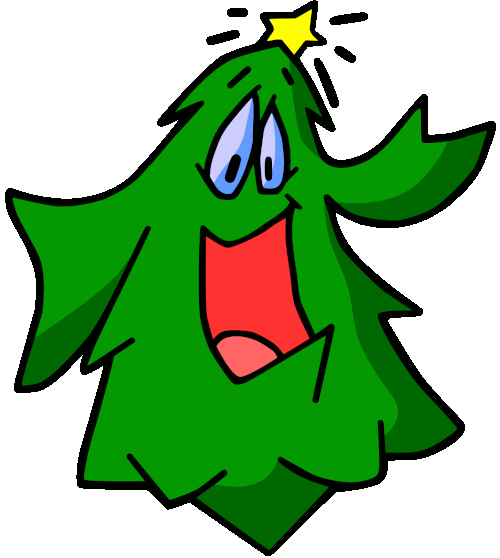CHRISTMAS:


https://www.google.com/maps/place/San+Pedro+Sula,+Honduras

| HOW TO SAY MERRY CHRISTMAS: | |
|---|---|
| In Spanish | Feliz Navidad |

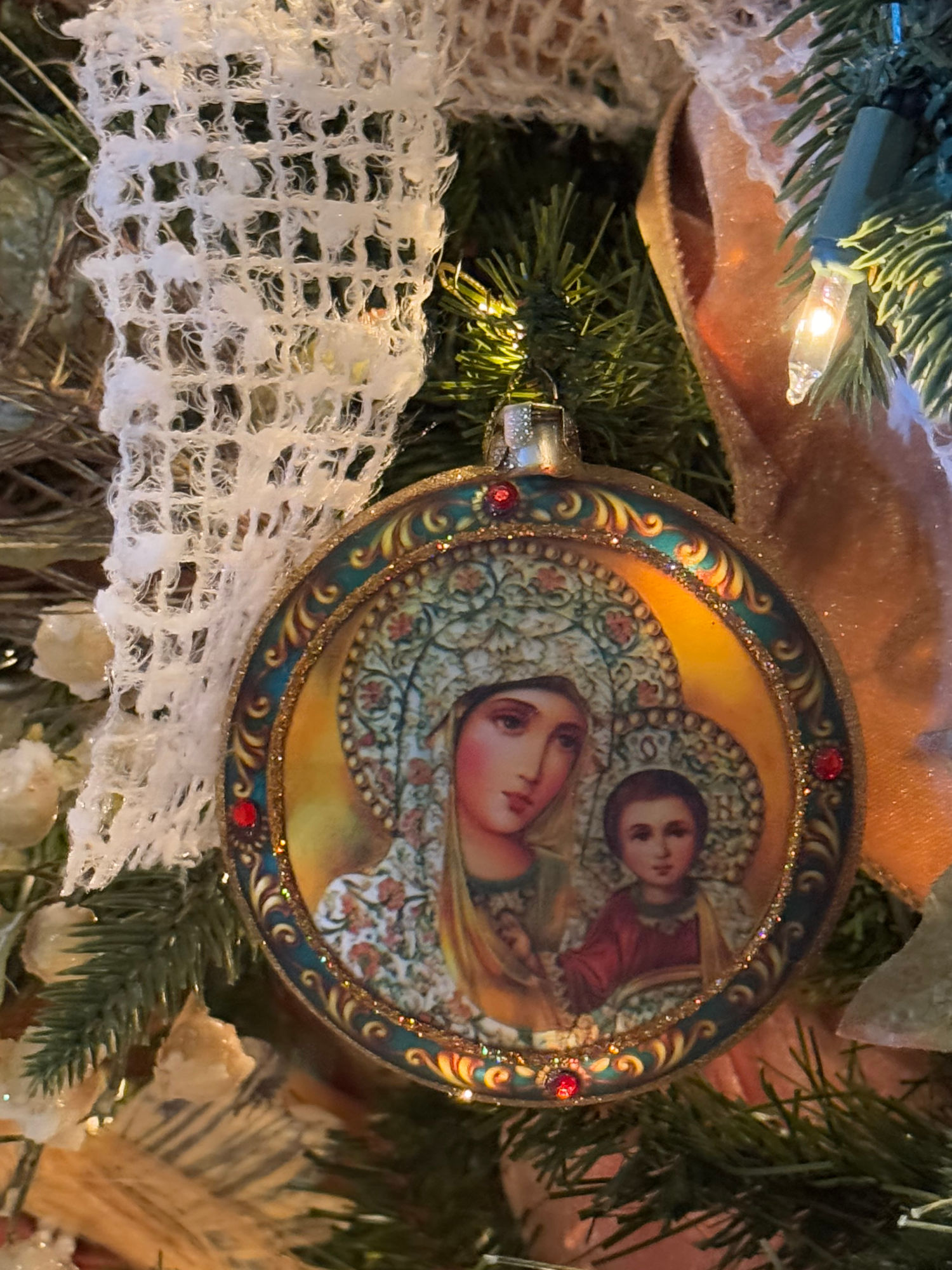
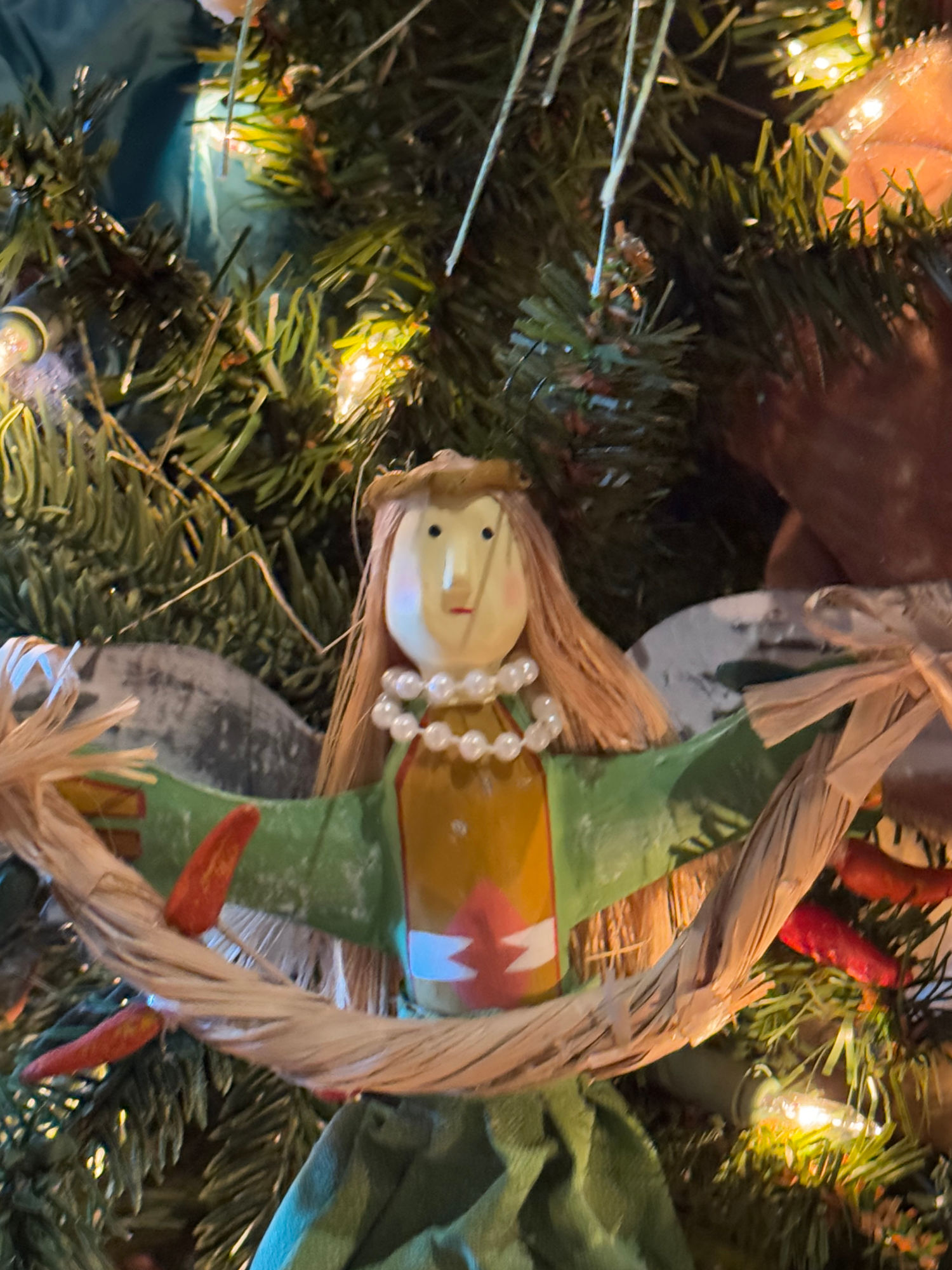
WHYCHRISTMAS.COMChristmas in Honduras
Christmas is a very important holiday in Honduras as a lot of the population are catholics. The Christmas period starts with Advent, when some people will fast leading up to Christmas.
- During Advent there are also Christmas plays called Pastorelas (The Shepherds) which tell the story of the Shepherds going to visit Jesus as a baby.
- Posadas are popular in Honduras, as in many other latin American countries - especially Mexico. From December 16th to Christmas Eve, in La Posadas, children will lead processions around their neighborhoods. They remember the part of the Christmas story where Mary and Joseph travelled to Bethlehem and looked for somewhere to stay.
- Christmas Eve is called 'Noche Buena' (the good night) and is when the main Christmas celebrations and meal take place. The main meal will often consist of roast pork, turkey or chicken; and there will be 'Nacatamales' - these are like tamales but are moister. They can contain chicken or pork, rice, potatoes, olives, vegetables and raisins. Often apples and red grapes are on the Christmas table and can also be given as small gifts. For dessert you might have 'Rosquillas en Miel' which are donuts soaked in honey. A popular drink is Rompopo, which is like eggnog.
- On Noche Buena, people often wear some new clothes and/or shoes - which are known as 'estreno'.
- Either before or after the meal, many people will go to a church service on Christmas Eve. At midnight there are lots of fireworks, sometimes lasting all night long!
- Christmas Tress are becoming more popular; but having a nativity scene 'nacimiento' is also very important and most houses will have one.
- Some people will exchange presents on December 24th/25th but many children also hope that The Three Kings will bring them presents at Epiphany and Epiphany Eve (5th/6th of January). On Epiphany, also called Three Kings Day, there are street parades of people dressed as the Kings.
- A New Year's custom is making a life sized 'Maniqui' (mannequin) and filling it full of news paper and firecrackers. At midnight it's set of fire! It's meant to represent all the bad things which happened in the previous years now being over. Often they are made to look like people don't like - they are often politicians!
- For many people in Honduras the new year officially starts with the striking of the bells on the clock at Comayagua Cathedral. The clock dates back to the 12th century and is the oldest clock in the Americas. The ringing of the clock is broadcast on TV and radio.
- In Honduras most people speak Spanish (Espanol), so Happy/Merry Christmas is 'Feliz Navidad'.


BloggerHonduran Christmas
Christmas traditions in La Ceiba aren't so different from those in the U.S., depending, of course, on the income level of the family. The traditions here in La Ceiba may have been influenced by the long-time presence of the Standard Fruit Company (Dole Co.), at one time the largest employer in the area.Presents
Christmas is very commercialized here, too. Right now the newspapers are full of ads for clothes, appliances, computers, and cellphones. The stores are full of trees, lights, decorations, and Santa Clauses.Children almost always receive a new set of clothes and shoes for Christmas. Often that is all that the family can afford and for some it may be their only pair of shoes.
I know some very poor families and I can tell you that those kids are as happy and proud to receive a new outfit as many North American kids may be to receive thousands of dollars of gifts. Dolls for girls and toy cars for boys are common presents and the quantity (and price) of presents increases with the wealth of the families, just like in the U.S.
The children's padrinos (godparents) sometimes give gifts to their godchildren. El Jefe's family was very poor. One year his three brothers received toy cars from their godfather. His godfather didn't give him anything so he sat around watching his brothers play with their new toys while he had nothing.
Another year, they all got up on Christmas morning to find no presents at all. El Jefe's mother told them that Santa Claus forgot their house that year. Sad, no? He doesn't ask for sympathy because being poor was just a fact of life to him. It made me very sad to hear it, though. It also makes me sad to think how parents must feel when they can't provide a gift to their children.
Church
Many churches have Christmas Eve or Christmas night services. Although Honduras is routinely reported as being 97% Catholic, my guess is that in La Ceiba that percentage is closer to 50%. There are many Evangelical churches, as well as a big Mormon church and other informal Christian churches as a result of the missionaries who come here.Las posadas is a tradition in which relatives all go to spend the night with one family on Christmas Eve or sometimes for several days. At midnight, everyone goes outside and hugs each other and thanks God for surviving another year. Some pass the night at their church. Wealthier families often spend Christmas time at their country or beach house.
Food
Christmas is not Christmas without tamales. For those who do not make their own, many women sell tamales at Christmas time, taking orders from friends and neighbors. They are often shared with neighbors or relatives as a gift in the way that those in the U.S. often exchange cookies or other treats at this time of year.Tamales are filled usually with a small chicken piece (including the skin and bones) or sometimes pork and some combination of rice, potatoes, garbanzos, peas, and green olives. Tamales are wrapped in banana leaves instead of corn husks. Some eat their tamales with ketchup.
Arroz con pollo (rice with chicken) is a popular celebration meal, as is a similar dish that includes bits of other meats and is called Chop Suey − El Jefe frowns on this practice. Whatever is served absolutely must be accompanied with tamales. No exceptions.
Sandwiches (usually chicken on sliced white bread with mayonnaise, ketchup, and mustard) are another popular food this time of year. Cake is often served to guests, as is rompopo (eggnog). Red grapes and apples are traditional at Christmas time; the groceries and markets are full of them, including some of the biggest grapes I've seen in my life.
Frozen turkeys, canned cranberry sauce, and pumpkin pie filling are readily available in the grocery stores in La Ceiba. At a price, though! Cranberry sauce is being advertised right now for $1.59 per can (regular price $2.55) and I have paid as much as $40 for a medium-sized turkey, putting it well out of reach for most families.
Other Traditions
As shown in the pictures, many houses and palm trees are decorated with lights. Most decorations are behind the tall walls as it is likely that anything placed outside the walls would be stolen. By the way, in two of pictures, it looks as if it is snowing − nope. Those are raindrops.Middle or upper income families are likely to have an artificial Christmas tree. Pine trees are not grown nearby although they are grown in Honduras for wood.
An odd (to me) tradition is house painting. Many people paint their house at Christmas, some do it almost every year. It's odd to me because this time is right in the middle of La Ceiba's rainy season − not the best time to paint, so that may be why it has to be done so frequently.
Now for the Christmas traditions that I really dislike: Guns and fireworks all night long, especially at midnight on Christmas Eve and New Year's Eve, but continuing until almost daylight. Various cities and towns ban the fireworks each year but it doesn't seem to have much effect on the quantity available. Even small children can buy them at the corner pulperias (small grocery stores). Although we are still two weeks from Christmas, six children have already been hospitalized for burns from cohetes (firecrackers).
The guns are shot up in the air but what goes up, must come down. My neighbor told me that one year, his father got out of bed during the night. When he came back to bed, he found a bullet hole in his bed. A bullet had come through the roof and gone through his mattress right where he had been laying.
In addition to guns and fireworks, music so loud that you can't talk to one another is common in homes and businesses. Just walking down the street can be painful to your ears.
Other parts of Honduras may have different Christmas traditions. Maybe some of our Honduran readers will comment about them? All in all, except for the noise, Christmas isn't so different in La Ceiba than it is in the U.S.


Honduras got itself into the Christmas spirit in record breaking style earlier this month with a successful attempt at the Largest Human Christmas Tree world record.
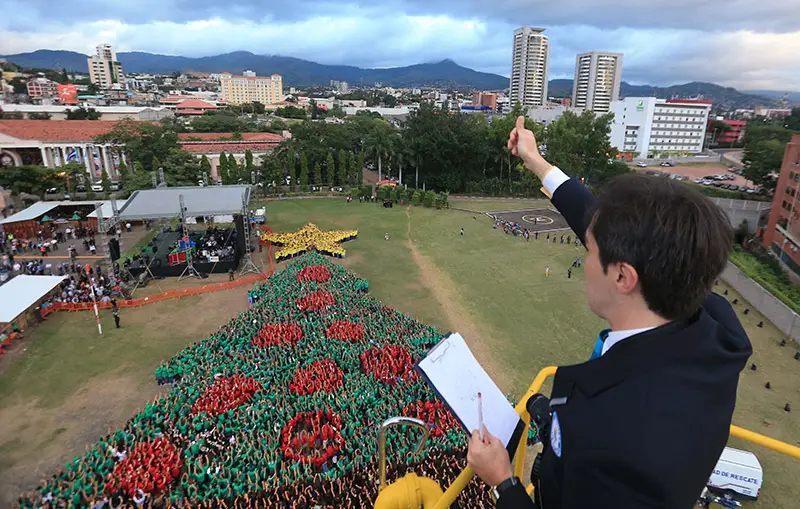
Formed by 2,945 volunteers and government employees, the huge human tree was formed at the Democracy Plaza of the Presidential House in the capital, Tegucigalpa.
Participants dressed in green and red gave shape to the Christmas tree, while others donned yellow outfits to form the star-shaped light on top.
In line with Guinness World Records guidelines, the tree remained motionless for over six minutes after which the participants were invited to join in Christmas festivities held by the government.
Organised by the government's Youth Office, the attempt aimed to bring a moment of peace to the population by celebrating the Christmas spirit.
Following confirmation that a record had been set by a Guinness World Records adjudicator, Honduran President Juan Orlando Hernandez, who promoted the initiative, was presented with an official certificate.


CHEF'S PENCILHonduran Christmas Food
Holiday traditions are important for Hondurans and food plays a very important role in every family. While traditional Honduran food is different among its many regions, when it comes to Christmas food all regions share similar dishes.The Christmas Eve is the most important day of the celebrations, gastronomically speaking. Hondurans, as in the rest of Central America, eat dinner early, around 6 or 7 in the evening. Usually a traditional Honduran dinner will consist of just one main dish, so by 8 o'clock, everyone is ready to watch a soap opera, then go to sleep.
This is what makes the Honduran Christmas dinner such a special occasion as it includes starters (also called boquitas), a variety of main and side dishes, and desserts, with festivities round the table lasting up to midnight.
- Starters
Typical Christmas starters include a variety of snacks, such as plantain chips or nachos with different dips, mini empanadas or mini catrachas (corn tostada with beans), fried tacos or sandwiches in small triangles.
- For starters, tapas, or snacks to "calm hunger", Hondurans prepare some special Christmas dishes, the best known being tamal. Tamal is served in many Latin American countries, and each country prepares it differently.
In Honduras, a traditional tamal contains green olives, rice, chicken or pork, small pieces of banana, potato, raisins, and green beans.
It is a delicious dish that is eaten throughout the Christmas season, but on Christmas Eve, it is a must.
- Main Dish
In Honduras, a main dish will usually consist of a meat-based dish, served together with a side – usually rice – and salad or vegetables. The main Christmas dish preserves this tradition and Hondurans will go for either stuffed turkey or baked pork leg.
- Baked pork leg is a delicacy that requires a lot of preparation. The meat is marinated for a day in brine with salt, pepper, cumin, and wine. The meat is punctured so that the flavors penetrate deep into the fibers for extra flavor and tenderness. Then the pork leg is cooked in the oven for approximately 3 hours.
- Besides baked pork leg, stuffed turkey is one of the most important dish in the Honduran Christmas dinner. Its preparation is a Christmas Day ritual. After marinating the turkey with seasonings during the afternoon it is baked in a slow oven and served with rice and salad.
- Sides
- The traditional rice dish, similar to turkey stuffing, includes raisins, corn, and petit pois.
- Green salad, potato salad or vegetable salad: Here we are a little more flexible. Any type of salad is fine, depending on the diners' preferences. What stands out in the Christmas salad is that it will include more elaboration and ingredients than everyday salads.
- Dessert
The main dessert at Christmas is torrejas, typical of Honduras but originating from Spain. It consists of a very soft bread soaked in a syrup, made with brown sugar or panela, seasoned with cloves and cinnamon.The recipe is different from the Spanish torrija as it includes a different type of bread and more autochthonous ingredients from Central America, such as panela.
- Drinks
A typical drink served at Christmas time, ronpope is made with egg and rum, with a touch of cinnamon and nutmeg.


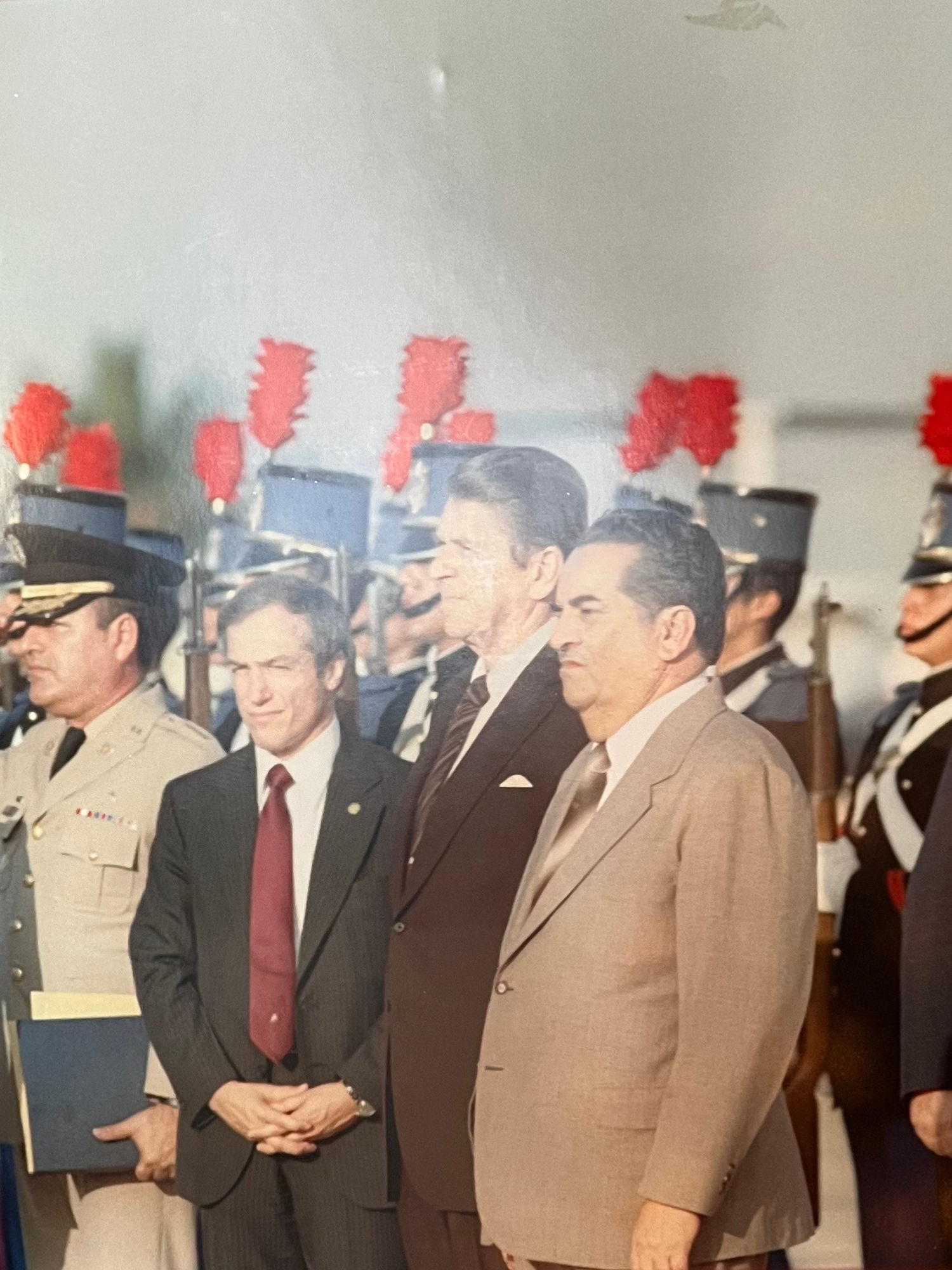
President Reagan and President Roberto Suazo Cordova at San Pedro Sula airport arrival ceremony, in Honduras; Working visit with President Suazo and Guatemalan President Rios Montt.
Ronald ReaganRemarks to the People of HondurasDecember 4, 1982
President Suazo has been gracious in inviting me to visit your country, and I'm anxiously looking forward to it. Early this summer, we were honored to have your President visit Washington, and I'm happy to have this early opportunity to continue our talks.
He told me then of the pride of the Honduran people in their democratic achievement, of their desire for peace with their neighbors, and of the measures you are taking to revive your economy. These are all goals we share with you. Both of our countries are concerned by the economic problems and the threat to peace the countries in Central America face.
Honduras has been a leader in Central America. You've put forward concrete proposals for a comprehensive peace throughout your region. Your transition to democracy answered those who argue that freedom is a luxury that struggling countries cannot afford. And you've proved that a freely elected government has the will and determination to take the actions needed to put your economy on a sound course.
The Honduran people have won the admiration of my fellow countrymen, and the peace proposals your President presented to the Organization of American States last March are ones which we in the United States support fully. They were incorporated in the Final Act of the eight democratic countries that met in San Jose in October. They are reasonable and attainable for all parties, and I hope they will lead to peace in Central America.
Honduras has also played a prominent role in the Central American Democratic Community, which is dedicated to freedom, economic development, and the security of each nation against aggression in any form by one neighbor against another. These are goals which can be achieved, and it is with this hope that I will come to Honduras to meet with President Suazo.
We have common aspirations and values. I'm sure we will be able to strengthen the cooperation between our two nations and our people. I will bring with me the best wishes and friendship of the American people.
Thank you.
NOTEThe President's remarks were taped on November 22 at the White House for later broadcast on Honduran television.
WIKIPEDIAThe Republic of Honduras
A country in Central America. The republic of Honduras is bordered to the west by Guatemala, to the southwest by El Salvador, to the southeast by Nicaragua, to the south by the Pacific Ocean at the Gulf of Fonseca, and to the north by the Gulf of Honduras, a large inlet of the Caribbean Sea. Its capital and largest city is Tegucigalpa.Honduras was home to several important Mesoamerican cultures, most notably the Maya, before the Spanish colonization in the sixteenth century. The Spanish introduced Catholicism and the now predominant Spanish language, along with numerous customs that have blended with the indigenous culture. Honduras became independent in 1821 and has since been a republic, although it has consistently endured much social strife and political instability, and remains one of the poorest countries in the Western Hemisphere. In 1960, the northern part of what was the Mosquito Coast was transferred from Nicaragua to Honduras by the International Court of Justice.
The nation's economy is primarily agricultural, making it especially vulnerable to natural disasters such as Hurricane Mitch in 1998. The lower class is primarily agriculturally based while wealth is concentrated in the country's urban centers. Honduras has a Human Development Index of 0.625, classifying it as a nation with medium development. When adjusted for income inequality, its Inequality-adjusted Human Development Index is 0.443.
Honduran society is predominantly Mestizo; however, there are also significant Indigenous Americans, black and white communities in Honduras. The nation had a relatively high political stability until its 2009 coup and again with the 2017 presidential election.
Honduras spans about 112,492 km2 (43,433 sq mi) and has a population exceeding 10 million. Its northern portions are part of the western Caribbean zone, as reflected in the area's demographics and culture. Honduras is known for its rich natural resources, including minerals, coffee, tropical fruit, and sugar cane, as well as for its growing textiles industry, which serves the international market.

- Honduras is divided into 18 departments. The capital city is Tegucigalpa in the Central District within the department of Francisco Morazan. The north coast of Honduras borders the Caribbean Sea and the Pacific Ocean lies south through the Gulf of Fonseca. Honduras consists mainly of mountains, with narrow plains along the coasts. A large undeveloped lowland jungle, La Mosquitia lies in the northeast, and the heavily populated lowland Sula valley in the northwest. In La Mosquitia lies the UNESCO world-heritage site Rio Platano Biosphere Reserve, with the Coco River which divides Honduras from Nicaragua.
- The climate varies from tropical in the lowlands to temperate in the mountains. The Pacific coast is generally drier than the Caribbean.
- Honduras hosts more than 6,000 species of vascular plants, of which 630 (described so far) are orchids; around 250 reptiles and amphibians, more than 700 bird species, and 110 mammalian species, of which half are bats.
- Honduras has rain forests, cloud forests (which can rise up to nearly 3,000 metres or 9,800 feet above sea level), mangroves, savannas and mountain ranges with pine and oak trees, and the Mesoamerican Barrier Reef System. In the Bay Islands there are bottlenose dolphins, manta rays, parrot fish, schools of blue tang and whale shark.
- Football is the most popular sport in Honduras. Baseball is the second most popular sport in Honduras. Hondurans have consistently entered track & field and swimming games at the Summer Olympics since 1968 and 1984, respectively. Honduras has not won a medal in the Olympics and has not made notable results in other world championships yet.
- Honduras is governed within a framework of a presidential representative democratic republic. The President of Honduras is both head of state and head of government. Executive power is exercised by the Honduran government. Legislative power is vested in the National Congress of Honduras. The judiciary is independent of both the executive branch and the legislature.
- Honduras has a military with the Honduran Army, Honduran Navy and Honduran Air Force.
- The economy of Honduras is based mostly on agriculture, which accounts for 14% of its gross domestic product (GDP) in 2013. The country's leading export is coffee (US$340 million), which accounted for 22% of the total Honduran export revenues. Bananas, formerly the country's second-largest export until being virtually wiped out by 1998's Hurricane Mitch, recovered in 2000 to 57% of pre-Mitch levels. Cultivated shrimp is another important export sector.
- Along with neighboring El Salvador and Guatemala, Honduras forms part of the Northern Triangle of Central America, which has been characterized as one of the most violent regions in the world. Crime in Honduras is rampant and criminals operate with a high degree of impunity. Honduras has one of the highest national murder rates in the world; cities such as San Pedro Sula and the Tegucigalpa likewise have registered homicide rates among the highest in the world. The violence is associated with drug trafficking as Honduras is often a transit point, and with a number of urban gangs, mainly the MS-13 and the 18th Street gang. Homicide violence reached a peak in 2012 with an average of 20 homicides a day.
- The World Bank categorizes Honduras as a low middle-income nation. The nation's per capita income sits at around 600 US dollars making it one of the lowest in North America. Levels of income inequality in Honduras are higher than in any other Latin American country.
- The ethnic breakdown of Honduran society was 90% Mestizo (mixed Amerindian and European), 7% American Indian, 2% Black and 1% White (2017).
- Spanish is the official, national language, spoken by virtually all Hondurans.
- Most Hondurans are nominally Catholic: 51.4% of the population identified themselves as Catholic, 36.2% as evangelical Protestant.
- About 83.6% of the population are literate and the net primary enrollment rate was 94% in 2004. In 2014, the primary school completion rate was 90.7%.
- Honduran cuisine is a fusion of indigenous Lenca cuisine, Spanish cuisine, Caribbean cuisine and African cuisine. There are also dishes from the Garifuna people. Coconut and coconut milk are featured in both sweet and savory dishes. Regional specialties include fried fish, tamales, carne asada and baleadas.
The flag of Honduras is composed of three equal horizontal stripes. The blue upper and lower stripes represent the Pacific Ocean and the Caribbean Sea. The central stripe is white. It contains five blue stars representing the five states of the Central American Union. The middle star represents Honduras, located in the center of the Central American Union.
EtymologyThe literal meaning of the term "Honduras" is "depths" in Spanish. The name could either refer to the bay of Trujillo as an anchorage, fondura in the Leonese dialect of Spain, or to Columbus's alleged quote that "Gracias a Dios que hemos salido de esas honduras" ("Thank God we have departed from those depths").


